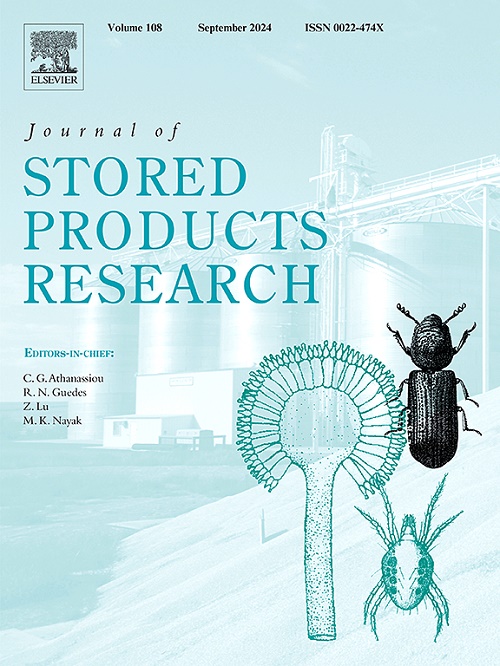Spillage and food dust do not decrease efficacy of long-lasting insecticide-incorporated netting against stored product insects
IF 2.7
2区 农林科学
Q1 ENTOMOLOGY
引用次数: 0
Abstract
The foundation of many postharvest integrated pest management (IPM) programs is proper sanitation. However, there may be deviations from this due to the effort, time, and cost required to keep a facility clean. Long-lasting insecticide-incorporated netting (LLIN) has been used successfully to augment post-harvest IPM programs, but has not yet been investigated for its role in supporting sanitation. Here, we investigated the use of LLIN to spot treat spillage and how food dust deposition may alter LLIN efficacy against Tribolium castaneum and Rhyzopertha dominica. After immersing 0.34 % alpha-cypermethrin LLINs in flour, we found no significant changes in adults of both species classified as alive, affected, and dead compared to undipped LLINs. We found slightly more recovery by T. castaneum after exposure to 0.4 % deltamethrin LLIN in the presence of food dust compared to when it was absent, but there was no effect on recovery for R. dominica. When a layer of LLIN was used to cover spillage, we found statistically equivalent numbers of affected and dead individuals induced compared to when spillage was absent. After holding spillage for 6 weeks, no larvae and 87 % fewer pupae were produced by T. castaneum after exposure to a layer of alpha-cypermethrin LLIN for 48 h, compared to netting without insecticide. Finally, we found a 2.5 cm strip of LLIN sufficiently impeded the dispersal of R. dominica on a site of spillage, but this was not the case for T. castaneum. Overall, these results suggest the use pattern for LLIN could be expanded, and that food dust will minimally affect LLIN efficacy against stored product insects, most likely due to the high concentration of the active ingredient in LLIN.

溢出和食物粉尘不会降低长效杀虫剂网对储存产品昆虫的功效
许多收获后病虫害综合治理(IPM)计划的基础是适当的卫生。然而,由于保持设施清洁所需的努力、时间和成本,可能会有偏差。长效驱虫蚊帐(LLIN)已成功用于加强收获后IPM项目,但尚未对其在支持卫生方面的作用进行调查。在此,我们研究了使用LLIN来现场处理溢出,以及食物粉尘沉积如何改变LLIN对栗霉和灰霉的功效。将0.34%的高效氯氰菊酯LLINs浸泡在面粉中后,我们发现与未浸泡的LLINs相比,两种成虫的活、受影响和死亡分类均无显著变化。我们发现,在有食物粉尘存在的情况下,暴露于0.4%溴氰菊酯LLIN后,与不存在食物粉尘时相比,castaneum的回收率略高,但对多米尼加小蠊的回收率没有影响。当使用一层LLIN覆盖溢出时,我们发现与没有溢出时相比,统计上受影响和死亡的个体数量相等。保温6周后,一层高效氯氰菊酯LLIN处理48 h后,与不撒网相比,castaneum无幼虫,蛹产量减少87%。最后,我们发现一条2.5 cm的LLIN条足以阻碍多米尼加白尺蠖在泄漏地点的扩散,但对castaneum没有这种情况。总的来说,这些结果表明,LLIN的使用模式可以扩大,并且食品粉尘对LLIN对储存产品昆虫的功效影响很小,这很可能是由于LLIN中含有高浓度的活性成分。
本文章由计算机程序翻译,如有差异,请以英文原文为准。
求助全文
约1分钟内获得全文
求助全文
来源期刊
CiteScore
5.70
自引率
18.50%
发文量
112
审稿时长
45 days
期刊介绍:
The Journal of Stored Products Research provides an international medium for the publication of both reviews and original results from laboratory and field studies on the preservation and safety of stored products, notably food stocks, covering storage-related problems from the producer through the supply chain to the consumer. Stored products are characterised by having relatively low moisture content and include raw and semi-processed foods, animal feedstuffs, and a range of other durable items, including materials such as clothing or museum artefacts.

 求助内容:
求助内容: 应助结果提醒方式:
应助结果提醒方式:


